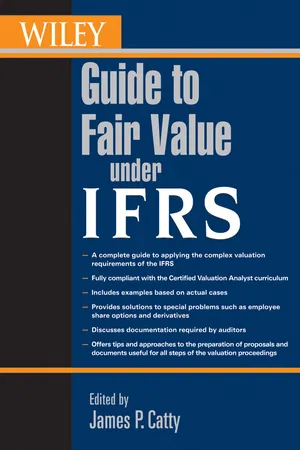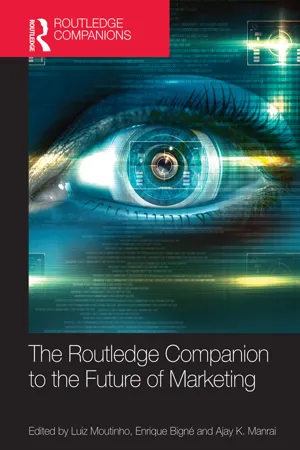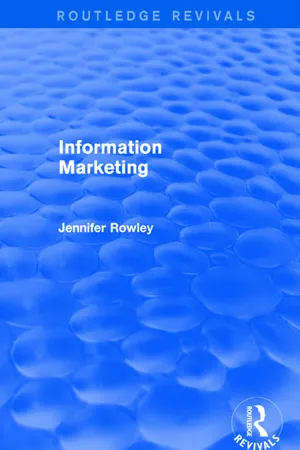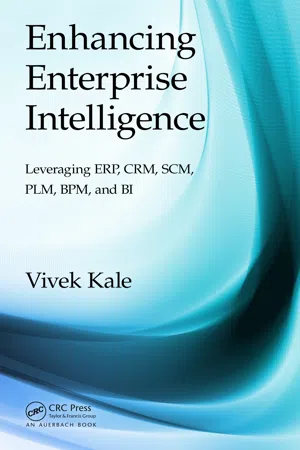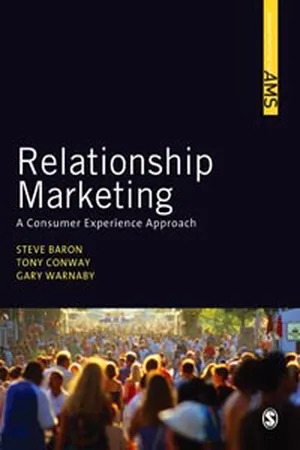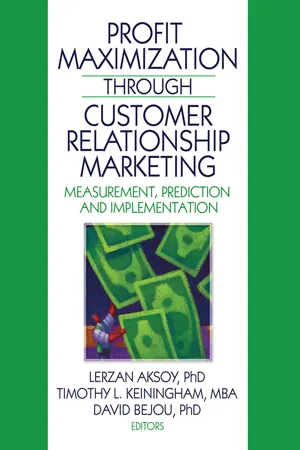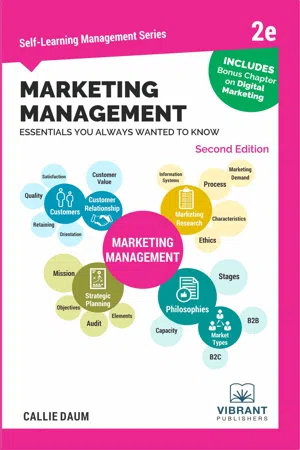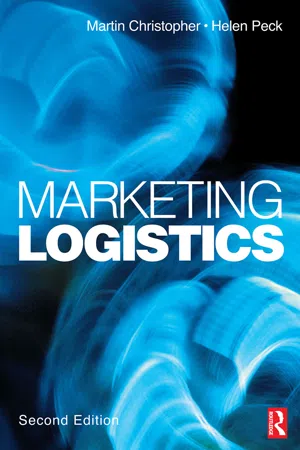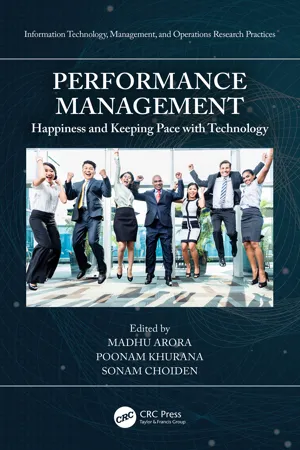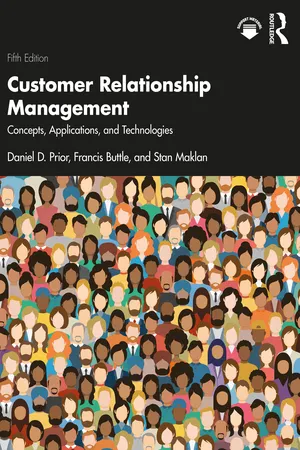Economics
Long Term Customer Relationship
A long-term customer relationship refers to a sustained association between a business and its customers over an extended period. This relationship is characterized by ongoing interactions, trust, and loyalty, leading to repeat purchases and customer retention. Businesses aim to cultivate long-term customer relationships as they often result in higher customer lifetime value and contribute to the overall success and stability of the business.
Written by Perlego with AI-assistance
Related key terms
Related key terms
1 of 4
Related key terms
1 of 3
12 Key excerpts on "Long Term Customer Relationship"
- eBook - ePub
Wiley Guide to Fair Value Under IFRS
International Financial Reporting Standards
- James P. Catty, James P. Catty(Authors)
- 2010(Publication Date)
- Wiley(Publisher)
16 CUSTOMER RELATIONSHIPSBRANDI L. RUFFALOUNITED STATESINTRODUCTION
The customer is king in all businesses. Without buyers for products or services, the firm will fail. Although they are important to every entity, not all businesses have customer relationships; those are created through ongoing, repeated interactions between buyers and an entity. They lead to clients developing a good impression of the firm, thereby improving the chances they will continue to buy. The expectation of continuing sales to existing customers due to such relationships is a valuable intangible asset. In fact, numerous firms have been acquired for the sole purpose of gaining access to their customers. Customer relationships are among the most prevalent intangible assets, even within large, multiline organizations.For many entities, the ability to retain long-term relationships with loyal customers remains a primary objective, as each interaction creates ongoing, lasting financial benefits. In the extreme form, customer relationships are the predominant driver of a firm’s value. Here is the sum of the lifetime values of existing and future purchasers. From a purely mathematical point of view:All Customers All CustomersThe importance of identifying and quantifying customer relationships, which can be one of the most valuable soft assets, has increased substantially over the past few years due to the introduction of International Financial Reporting Standard (IFRS) 3.Variables that Define Customer Relationships
Obtaining customers through advertising, promotions, word of mouth, and other marketing endeavors is an essential activity to a successful business. A description of the necessary techniques is beyond the scope of this chapter, but the general idea to “first get ’em, then massage ’em” has been successfully practiced for centuries. Add to this, the need to obtain as much information as possible about them and their buying habits. - Luiz Moutinho, Enrique Bigné, Ajay K. Manrai, Luiz Moutinho, Enrique Bigné, Ajay K. Manrai(Authors)
- 2014(Publication Date)
- Routledge(Publisher)
Value components other than “purchase value” ultimately create customer purchase value or reduce the cost of the firm (e.g. by reducing cost of technical support and promotions). They allow opportunities for firms to improve upon their customer management strategy. Research linking these other types of customer values to customer purchase value and cost reduction would allow firms to estimate these value components better and use them appropriately. Evidence suggests that even in the absence of sophisticated methods, firms are using simple heuristics to rank customers based on these different types of value components. For example, firms now select online advocates based on their reach and activism and then seek their support for promotions, new product launches, positive word of mouth, and neutralizing negative word of mouth. Firms select and reward people most active in providing technical support to their customers. All this is akin to the traditional use of some proxy for customer value such as forms of Recency, Frequency, and Monetary (RFM) framework.The area of customer relationship management is rich and significant research has led to important developments for practice. For further readings in this area, we suggest Customer Relationship Management: Concept, Strategy, and Tools by Kumar and Reinartz (2012), which provides an extensive treatment of the strategic and tactical aspects of customer relationship management as we know it today, “Referral Programs and Customer Value” by Schmitt, Skiera, and Bulte (2011), which investigates the extent to which referred customers are more profitable and more loyal, and “Measuring Customer Lifetime Value: Models and Analysis” by Singh and Jain (2010) which is an exhaustive survey of models of Customer Lifetime Value.Our discussion so far highlights issues that the traditional concepts of “customers” and “lifetime” cannot appropriately address. First, not all those who are valuable to the firm would be its customers. Therefore, to effectively apply the idea behind the concept of customer value, it has to be broadened to include all those who impact the firm and its offerings. Perhaps some term such as “stakeholders” might be more appropriate. Second, how we estimate “stakeholder” lifetime itself would be different for different value components. For “purchase value”, traditional customer lifetime estimates would remain valid. For other stakeholders this might change. For example, in the evaluation of “advocate value” the lifetime of an advocate would be how long she remains an advocate of the firm and its related issues. Naturally, a firm would want to focus its limited resources on engaging those who have more influence and who are expected to continue their advocacy for a longer time period. In summary, our argument is to broaden the fundamental concept of customer lifetime value based on new realities. We have presented ways in which this can be done to make it more relevant to practice. We hope that our arguments for moving from “customer lifetime value” to the new framework of “stakeholder lifetime value” would help companies understand the next stage of evolution of this area.- eBook - ePub
- Jennifer Rowley(Author)
- 2017(Publication Date)
- Routledge(Publisher)
Perhaps one way to encapsulate the difference in emphasis between transactional and relationship marketing is in terms of the measures of success that are applied in the two approaches. In traditional marketing, market share is used to assess marketing success, whereas relationship marketing measures customer retention. Gronroos (1991) suggests that all marketing strategies lie somewhere on a spectrum from the transactional to the relational. A further difference between traditional marketing and relational marketing is that the earlier role of marketing was to create customers, whereas in relationship marketing the emphasis is on customer retention.Relationship marketing encourages organizations to take a longer-term perspective. Investment in customer relationships creates a community for and with whom the organization can develop its products and marketing communication strategies. Enduring relationships with customers cannot be duplicated by competitors, and therefore provide a unique and sustainable competitive advantage.Loyalty is seen as a key characteristic of relationships with customers. It can be regarded as a measure of whether the customer behaves and has attitudes that suggest a relationship with an organization. Organizations are concerned to secure as significant a loyal customer base as possible, because of the perceived link between loyalty and business performance. Loyal customers form a stable target market, and do not require the same level of marketing attention as customers who need to be wooed.The service experience can play a significant role in shaping relationships, as it is the interaction between the customer and the supplying organization. An understanding of the service experience offers an additional insight into one important arena in which customer relationships are honed. The literature on the service experience tends to focus on episodes (although there is reference to a more longitudinal perspective in the literature on quality), whereas the literature on loyalty is concerned with the longer-term relationship between the customer and the organization.RELATIONSHIPS
Library and information services recognize the importance of establishing an appropriate relationship with the customer, as is evidenced, for example, in public libraries through an emphasis on customer care, and in academic libraries through the appointment of subject specialists. This commitment to customer service is well established. Nevertheless, some of the ideas from relationship marketing offer new perspectives. - Vivek Kale(Author)
- 2016(Publication Date)
- Auerbach Publications(Publisher)
Chapter 2, section “Time Value of Customers and Shareholder Value” elaborates on the concept that a company’s market valuation/capitalization is truly dependent on the sum total of the envisaged life time value of its current and future customers. The market valuation in turn determines the company’s share price on the stock markets. Patricia Seybold was the first one to point out that the success in the customer economy will depend on companies managing their enterprises by and for customer value—they will have to use customer lifetime value (CLTV) as a strategic management tool. The company’s source of investor value will increasingly be based on the value of their customer franchise, the lifetime customer value of their present and future customers.Summary
Customer relationship strategy is emerging as one of the most important components of corporate strategy for competitive differentiation and shareholder value. The concept of CRM aims at identifying the customers that are more profitable to the company, and helps in optimizing relationships with those customers. In today’s world of decreasing margins, increasing competition, and an ever-changing business environment, corporate success depends on an enterprise’s ability to build and maintain loyal and valued customer relationships. The key to forge long-term, profitable relationships with valuable customers is customer centricity. A major step in this direction is to realize that whereas customer relationships are not all about information, all customer-related information is certainly about customer relationships.- eBook - ePub
Relationship Marketing
A Consumer Experience Approach
- Steve Baron, Tony Conway, Gary Warnaby(Authors)
- 2010(Publication Date)
- SAGE Publications Ltd(Publisher)
3 Customer Retention and Loyalty
Learning objectives
• To outline the key features of customer retention and particularly customer loyalty. • To highlight the variety of influences on this loyalty and the practical implications of these for reward schemes. • To outline and evaluate the concept of ‘customer equity’.Introduction
The previous chapter highlighted the change in focus from transactional marketing to a more long-term, on-going relational approach that produced mutual benefit to the participants. The key benefit to the organization was that as long-term relationships with customers could not be duplicated by the competition, unique and sustainable competitive differentiation could be produced. Pursuing a retention strategy allows the firm to gain the benefits of it being cheaper to retain an existing customer than it is to acquire a new one and to experience a more profitable relationship as a result of a longer association (Reichheld and Sasser 1990). This is what can be considered to be the ‘loyalty ripple effect’ (Gremler and Brown 1996). Customer retention, therefore, becomes a measure of marketing success (Christopher et al. 1991; Grönroos 1996). Relationship Marketing (RM) places a good deal of stress on loyalty as reducing customer defection rates is critical to retention and ‘customer loyalty’ is now being used as well as ‘brand loyalty’ to emphasize the interactive nature of the commitment of the customer to the firm and/or its employees. As marketing is increasingly being defined in relationship terms, there is clearly a need for the effective management of loyalty (Fournier and Yao 1997). - eBook - ePub
Profit Maximization Through Customer Relationship Marketing
Measurement, Prediction, and Implementation
- Lerzan Aksoy, Timothy Keiningham, David Bejou(Authors)
- 2014(Publication Date)
- Routledge(Publisher)
Oliver (1999) notes that loyalty itself cannot be pursued as a reasonable goal because of the nature of some product categories, or because of consumer disinterest. Loyalty is an intermediary concept, something that organizations can define and measure, but not something they can directly create, and certainly not something that represents their ultimate objective. Nevertheless, building customer loyalty is an effective component of marketing strategy. Strategies for building loyalty include specialized customer service, customized product offerings, personal interactions, and added product or service benefits, particularly as surprises and delights (Collinger 2003).We close this section by connecting the elements of loyalty to customer value. Figure 1 posited a “value chain” from loyalty to purchasing, to customer value to company performance. The link between brand loyalty and customer value can be isolated and expanded as follows:What Consumers Have or Make… What Company Offers or Gets… Brand affinity or commitment Product offerings Purchase behavior Revenue from sales Individual-level Share of wallet Market-level Market share Brand or company relationship Customer value A key connecting point is that both loyalty and customer value are centered on the idea of relationships over time. Brand loyalty rests upon a commitment to buy over time and customer value represents the financial inflow to a company from repeat purchases. Implicit in the abundance of research and writing about brands, brand loyalty and brand equity over the past years is the idea that brand or customer loyalty translate directly into financial performance. One of our objectives is to make that connection more explicit and conceive of loyalty as it pertains to customer value.Customer ValueThe value of a customer can be partitioned into two parts, the value realized in the past and future. Customer long-term value (CLV) of a customer has been defined as “the present value of the future cash flows attributable to the customer relationship over the lifetime of that relationship (Pfeifer and Bang, 2005, p. 49).” The idea of CLV is to quantify how much profit the firm expects to make from some customer in the future. Historical value quantifies the profits a customer has generated in the past.We use the term “long-term” rather than “lifetime,” which is used by many other authors, for two reasons. First, in our experience managers are more interested in the long term than the lifetime. Few managers are willing to wait a lifetime for their, e.g., customer acquisition investments to pay off. Instead, they would like to show profits over a multi-year “long-term” horizon, before they move on to their next job. Second, there is considerable uncertainty in making lifetime forecasts, especially at the individual level. - eBook - ePub
Marketing
A Relationship Perspective
- Svend Hollensen, Marc Oliver Opresnik(Authors)
- 2019(Publication Date)
- WSPC (US)(Publisher)
lifetime value’ concept concludes that an enterprise should restrict taking a short-term view but rather should consider the income derived from that company’s lifetime association with the consumer. In the framework of an integrative customer retention strategy a company should consequently project the value of individual customers over time rather than focus on customer numbers only (Dawes and Swailes, 1999).Decisions concerning investment in relational approaches should be made on the basis of the customer’s lifetime value. These investments may include those designed to enhance product or service quality in order to improve competitive positioning, or defensively to discourage defection to the competition. In the latter case the enterprise can create ‘exit barriers’ to promote retention by makingswitching costshigh.Switching costs are effectively barriers to exit from the relationship from the perspective of the customer. In this respect RM strategies are likely to be more successful if there are long time horizons and high switching costs. These are monetary and non-monetary costs that customers face when switching from one supplier to another. (Kinard and Capella, 2006). Switching costs may be created by the supplier, by the customer or by the relationship itself and include for example search costs, learning costs, emotional costs, financial costs and legal barriers (Egan, 2008).Relationship Longevity
As stated above, customer retention leads to enhanced revenue, reduced costs and improved financial performance. The benefits that contribute to an entire ‘life cycle of profits’ from the customer are as follows (Figure 1.3 ):• profit growth as a result of increased buying frequency and higher average purchases• profit due to lower distribution and administration costs• profit because of recommendation• profit out of mark-ups1.4 Relationship Drivers
Within the previous sections the concept of ‘driver’ toward relational strategy was already introduced and discussed, such as high customer acquisition costs and high exit barriers. In this part we will look at other drivers that appear to have an important bearing on the decision to develop a relationship marketing approach, in particular: - eBook - ePub
- Naresh K. Malhotra, Can Uslay, Ahmet Bayraktar(Authors)
- 2016(Publication Date)
- Business Expert Press(Publisher)
CHAPTER 7 Customer Relationship Management AnalyticsIntroductionThis chapter introduces the role and benefits of customer relationship management (CRM) and the historical development of the CRM concept. In addition, it discusses how to measure and manage customer value and customer lifetime value (CLV) by presenting various approaches and principles. Besides, it introduces two types of strategies, namely, “across-customer” strategies and “within-customer” strategies, which help companies maximize CLV. The chapter also discusses the importance of CLV-based marketing initiatives, which channel firms’ efforts toward customer-centric marketing and away from product orientation. After introducing CRM solution providers, the chapter concludes with two cases that illustrate how CRM technologies can help firms grow their business and play a key role in achieving long-term success by transforming the whole company.Are Loyal Customers Profitable Customers?Behavior loyalty is not a very good predictor of retention and represents an even worse predictor of customer satisfaction. For example, customers under service contracts can appear to be loyal for the duration of the contract but switch to a competitor with better pricing as soon as the contract expires. Satisfaction is a matter of meeting or exceeding past expectations; however, loyalty also includes an expectation of future actions.1 Therefore, the two do not always go hand in hand. According to one study, 75 percent of consumer wireless phone service customers were found to be satisfied, but 72 percent would be willing to switch to a competitor.2Even attitudinal loyalty may not necessarily reflect in profitability. A customer may be really happy with a BMW that he or she purchased at a year-end sale and have very favorable expressed loyalty toward the brand. However, that becomes much less meaningful to the company if the customer enjoys the car for some 20 years and never gets it serviced at a BMW dealer once the warranty expires. These nuances underline why CRM applications have become increasingly important during the past three decades. - Callie Daum, Vibrant Publishers(Authors)
- 2020(Publication Date)
- Vibrant Publishers(Publisher)
How much is a customer worth? This is a critical question to ask when considering how much an organization is willing to spend to improve quality to retain customers and gain new ones. A profitable customer is a customer whose revenues, during a specified period of time, are greater than the organization’s costs of marketing, selling, and servicing that customer. For customer profitability, we are not focused on a single transaction but the lifetime revenues and costs. This is termed customer lifetime value – the amount where revenues exceed organization costs over a specified period of time. Measuring customer value and profitability is a challenge because often transactions can be spread across multiple departments. The organizations that have been successful at tracking customer profitability and lifetime value have been surprised at how unprofitable their customers are.Retaining Customers
When there is high customer turnover, costs are higher than if all customers are retained and no new ones are obtained. Organizations have to take the time to monitor what their customer rate of defection is. The first step in doing this is to state, monitor, and measure the rate of retention. If you are an organization that offers a subscription service, your retention rate may be your renewal rate. Next, the organization should define the different causes for why patients defect and determine which of these can be addressed. An easy way to do this is to conduct a satisfaction study.When retaining customers, it is important to note that customers do switch providers when they think a better value is out there. Even if they incur high switching costs (i.e. learning a new product, learning a new service), customers will deal with it. There is little research that suggests that incompatibility gives an organization a real advantage at the end of the day. What’s more important is to have the best product or service out there and not focus on being first to market or a grand base of customers. Remember, the incompatibility (or high switching costs) outside of purchase price are not as important to the customer as a better offer.Relationship Marketing
A marketing function where organizations develop, maintain, and improve strong relationships with high levels of value with customers and stakeholders. Notice that the focus is on long term relationships and not transactions. The goal here is to provide value to customers for the long term and term success as long term customer satisfaction.- eBook - ePub
- Martin Christopher, Helen Peck(Authors)
- 2012(Publication Date)
- Routledge(Publisher)
Chapter 2Building customerrelationships
As markets mature and the cost of winning new customers steadily increases, greater emphasis needs to be placed upon retaining existing customers and building the business that is done with them. Market share, which for long was the overriding goal of many corporations, is being replaced by a focus on customer share – in other words, what share of the customer’s spending are we getting, and what is the quality of that share (i.e. how loyal are those customers?). Much evidence exists to suggest that retained customers are generally more profitable than new ones, and hence the marketing challenge is to find ways of building enduring relationships with selected customers. Whilst many factors will influence the quality and longevity of a customer relationship, it will usually be the case that superior service performance will be a key determinant of customer retention.Customer retention strategies
It has been suggested that it costs up to five times as much to win a new customer as it does to retain an existing one. The costs of capturing market share are not always easy to gauge, but there are many companies now that regret earlier strategies that were based upon the blind pursuit of volume. Whilst there is strong evidence for the link between market share and profitability, there is equally strong evidence to show that it is the quality of that market share that counts. In other words, does our customer base comprise, in the main, long-established, loyal customers, or is there a high degree of turnover or ‘churn’? If the latter is the case, then the chances are that we are not as profitable as we might be.Bain & Company, the international consulting company, has suggested that even a relatively small improvement in the customer retention rate (measured as the percentage of retained business from one period to another) can have a marked impact upon profitability. They suggest that on average, an improvement of 5 percentage points in customer retention can lead to profit improvements of between 25 and 85 per cent in the net present value of the future flow of earnings. - eBook - ePub
Performance Management
Happiness and Keeping Pace with Technology
- Madhu Arora, Poonam Khurana, Sonam Choiden, Madhu Arora, Poonam Khurana, Sonam Choiden(Authors)
- 2020(Publication Date)
- CRC Press(Publisher)
Managing Customer Relationships Using Customer Lifetime Value and Customer Equity MetricsReetika JainCONTENTS
Introduction Need for the Study Customer Lifetime Value Customer Equity Value Conclusion ReferencesINTRODUCTION
Brand equity was the focus of marketing research in 1980s. Organisations are moving away from product or brand centric marketing towards a customer centric approach. To sustain in this increasingly competitive business world requires keenness on the part of businesses to serve the customers. This involves not only serving them, but also making them satisfied, as the entire business fulcrum is dependent on how happy and satisfied one’s customers are (Gupta and Lehmann, 2003; Gupta and Zeithaml, 2006). At the same time, it is indeed extremely difficult for businesses to satisfy all the customers equally, as some are more important than others in value terms. So, weeding out the unprofitable or least profitable from the whole breed of customers become necessary, otherwise a business would end up satisfying nobody, and incur huge losses for itself. Thus, prioritising the most profitable customers first, followed by less profitable customers down to the least profitable customers, will ensure efficient allocation of business resources at any point of time. Therefore, an effective relationship marketing strategy to retain profitable customers is a key step in this direction (Kumar, Ramani, and Bohling, 2004; Jain and Singh, 2002). The customer-centred viewpoint is reflected in the concepts and the metrics that drive today’s marketing world, such as customer satisfaction (Oliver, 1980), market orientation (Narver and Slater, 1990), and customer value (Bolton and Drew, 1991). Consequently, brand equity (a fundamental product-centred concept) has been challenged by customer-centred concepts like “customer profitability,” “customer lifetime value,” and “customer equity” (Blattberg and Deighton, 1996; Rust, Zeithaml, and Lemon, 2000; Blattberg, Getz, and Thomas, 2001). - eBook - ePub
Customer Relationship Management
Concepts, Applications and Technologies
- Daniel D. Prior, Francis Buttle, Stan Maklan(Authors)
- 2024(Publication Date)
- Routledge(Publisher)
As the customer-supplier relationship continues, it might become fully automated. Consider the direct debits you now have in place for your regular bills. Assuming there are no problems, the relationships you have as customer with many suppliers (e.g., utilities, TV streaming services) no longer require human intervention. This means that suppliers can cut many overhead costs due to automation.Over time, as relationships deepen, trust and commitment between the parties is likely to grow. Under these circumstances, revenue and profit streams from customers become more secure. One study, for example, shows that the average online clothing customer spends 67% more, and grocery customers spend 23% more, in months 31–36 of a relationship than in months 0–6.46 Retained customers are significantly less likely to shop around for a new auto insurance policy than newly recruited customers. Bundling multiple products and services can also enhance customer retention.47As customer tenure lengthens, suppliers can develop a better understanding of customer requirements and expectations. Customers’ buying histories offer important insights. Consequently, suppliers are better placed to identify and satisfy customer requirements profitably. Some companies employ a value ladder48 or value staircase49 to help them understand where customers are in terms of their tenure with the company.50 The idea is that customer behaviours change over time, so the length of their relationship with a given supplier is a determinant of changes in their behaviour. This is useful for the supplier since it allows them to adapt their offer. Climbing the value ladder often coincides with progress through stages in the customer journey. Table 2.4
Index pages curate the most relevant extracts from our library of academic textbooks. They’ve been created using an in-house natural language model (NLM), each adding context and meaning to key research topics.
Explore more topic indexes
Explore more topic indexes
1 of 6
Explore more topic indexes
1 of 4
